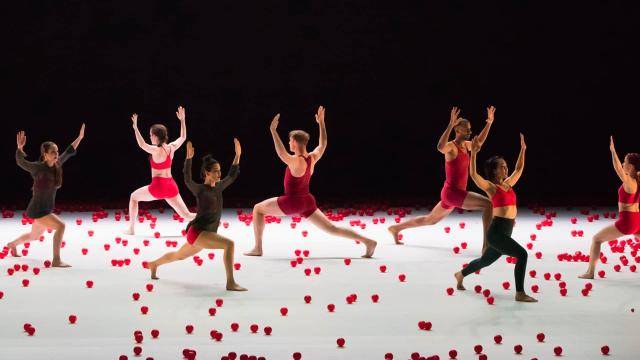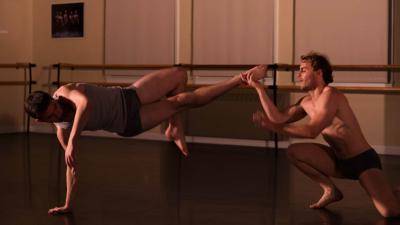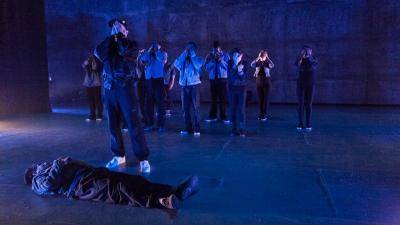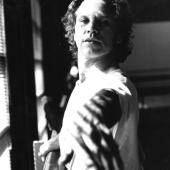Backhausdance is a frantically busy company. Their seasons of packed performances ricochet among small venues, schools, outdoor stages and traditional big stage venues such as Segerstrom, McCallum Theatre, The Alex Theatre, and Irvine Barclay theatre among others. On Saturday as part of the Carpenter Center’s dance series, the hectic schedule itself became part of the choreography for the closing work on the program, The Elasticity of the Almost, a sprawling theater dance premiere in which eight dancers, after a slow burn, eventually share the stage with thousands of bright red balls. All three works on the program were choreographed by Backhausdance Artistic Director, Jenny Backhaus.
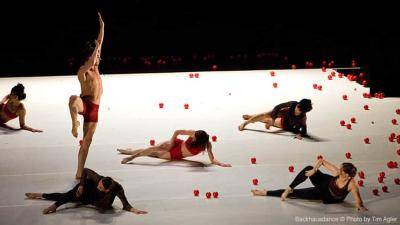
With a cobbled together sound score of music by Hauschka and the DJ artist Diplo (among others) Elasticity is something of an odyssey for both the dancers and the audience. The work opens with a metronomic beat as a background sound to which is added eventually a voice over of a “to do” list. The idea is that dance companies are complex and keeping them rolling is a tough juggling act. The movement is a clever combination of real dance and everyday action which spools out with growing physical intensity and complexity as the piece develops. You don’t have to go very far to put the balls into perspective. Except in this metaphor, the balls are not in the air but everywhere on the Carpenter Center’s expansive stage. The dancers have to develop special footwork to keep from crashing and burning. They corral them only to lose them just as quickly. The appeal is visual but the frustrations also become part of the humor inherent in the work. The dancers continually shift into new costumes but return to a basic outfit of red trunks and tops that make the obvious connection to the balls themselves. You could look for deeper meaning or, as successfully, let the physical overload of the movement be the main focus.
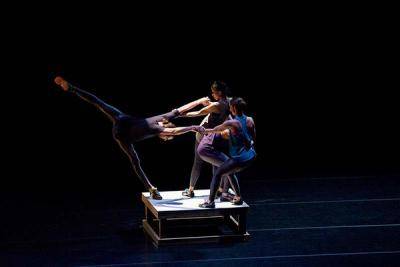
The evening opened with The Margin (2012) which also knit together dance and authentic movement as expressive partners. The music was a remix of Steven Reich. The set for the work, an eight foot square platform about two feet high, became alternately a refuge, a palanquin or a ricochet surface. The work, in two parts, opens with an ensemble section and concludes with solos and smaller combinations competing for space on the platform. In the final moment the eight dancers, lurking at the margins of the stage, make a break for the platform, landing together and competing for ownership. The Margin replaced Sitting on January originally scheduled on the program. I had hoped to see it again. It’s another Backhaus work where inventive dancing in hazardous situations prevails.
The Margin and Elasticity turn out to be like minded bookends for the evening. The heart of the program coalesced around a little duet(s), an ensemble work for three couples set to the concept album, An Invitation, by Inara George and Van Dyke Parks. The intimate music focuses on relationship and love and feels like a small scale, one woman opera. Backhaus excels with this kind of piece which is ideally suited to her inventive partnering style and loosely limned storytelling. I had seen the work in an earlier incarnation on the Studio Series at South Coast Repertory. Expanded and cut loose for the wide open spaces of the Carpenter stage and accompanied by Tiffany Williams beguiling colors and rich lighting designs, duet(s) looked like it had finally fulfilled its promise as a big stage work.
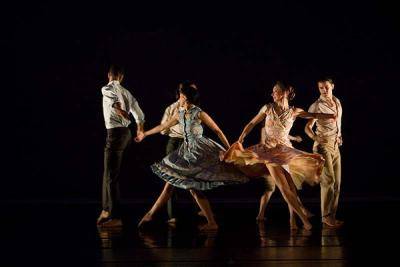
Duet(s) is set for an ensemble of shifting combinations for six dancers. The work is mostly optimistic. One of the pairings is set for two men. Their hookup figured as part of the evolving drama surrounding the romantic connections. In the opening tableau the dancers move as a group, shifting for position. It defines a moment full of possibility and expectation. Rhonda Earick’s creamy, monochrome costumes (capri pants, full-skirted dresses, and the men’s casual attire) dress characters that seem real but tinged with romantic flare. Excellent and secure partnering prevailed among the men, Joshua King, Zak Ryan Schlegel, and David Bagley. Bagley especially was buoyant and expressive, while Tawny Chapman and Amanda Kay White were fleet and convincing romantic companions. The pairings were not all sunny, however. In the final duo (Tell Me That You Love Me) Schlegel forcefully shucks his partner, the clinging Liane Aung. He’s moving on, she’s not. It’s an old story.
(The performance took place at Carpenter Center for the Arts in Long Beach, California on February 2, 2013.)
